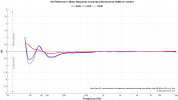It is certainly the case that pretty well none of the speakers on sale can reproduce the bandwidth of “high res” even if we could hear it, and a music distributor would be totally bonkers to make available a recording with even the full 16-bit dynamic range, never mind more since 99.99% of people who listen to music for enjoyment neither have a system which could reproduce it nor a room in which it could be enjoyed or headphones which wouldn’t damage their hearing.So that means half of our speakers cannot theoretically produce hi res ! When I look at the response of many of them, many stops or have a steep roll off after 20khz! So those according to Sonys logic are not hi res capable !
The one thing important to note in terms of 2 samples being enough to accurately code the waveform, this applies to a frequency limited signal. So sampling at 44.1 kHz theoretically accurately codes everything up to 22.05kHz but only if the signal is filtered such that there isn’t anything at a higher frequency than that, if the frequency being sampled has not been filtered the theorem is not valid.
I guess that is why 44.1 is OK it leaves margin for real world filters without encroaching on 20kHz.


